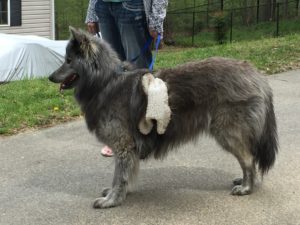Shadow’s owner contacted CPT due to concerns regarding aggressive posturing between Shadow and persons and dogs residing within the household. The behavior became prevalent after Shadow’s owner relocated from South Dakota to Hall County, GA.
To ease the financial burden of her move, Shadow’s owner moved-in with her sister, her sister’s adult son, her sister’s adult daughter, her sister’s young grandson, and her sister’s 5 dogs. Shadow did not acclimate well to the relocation and the crowded household. Likewise, the existing household dogs did not adjust well to the inclusion of a large, dominant dog (Shadow).
Her sister, the homeowner, had become afraid of Shadow, whereby she was hesitant to approach Shadow due to her increasingly frequent growling, and where Shadow was segregated from the other family dogs, due to the concern of conflict. Most egregiously, Shadow was occasionally growling at the young grandchild. To ameliorate the problem, Shadow’s owner contacted CPT for an in-home private behavior modification appointment with a CPT Head Trainer.

We started the session by compiling a thorough chronological, behavioral, health, and training history. We then observed Shadow and her interactions with the owner, the owner’s sister, the CPT Head Trainer, and the environment. Next, we identified the key trigger stimuli that provoked Shadow’s physical and vocal aggressive posturing. The stimuli were sudden human movement, petting atop the head, and the proximity of one of the 5 family dogs. We next designed a behavior modification program that included: a) clicker counterconditioning and systematic desensitization drills for each of the provocative stimuli, b) management protocols that prevented overexposure to provocative stimuli, c) management procedures for rotating dogs between indoor and outdoor areas, d) general impulse control training, e) human-dog leadership communication training, f) leash walking, and g) discussing with her local veterinarian the inclusion of fluoxetine to reduce Shadow’s general and state anxiety. After designing the referenced behavior modification strategies, we educated the owner how to implement the strategies, which included hands-on instruction regarding each of the counterconditioning, impulse control, and leash walking drills. We accomplished all the preceding in one 2.5-hour lesson.
A month and a half later the owner followed up with outstanding feedback. Shadow had stopped growling at the adults in the house. She became more relaxed around the family dogs, although they were still for the most part segregated. The owner was walking Shadow at least once per day and for the first time Shadow could walk on a loose leash without pulling. Inside the house, Shadow became more obedient, came immediately when called, and tended to walk calmly alongside the owner. Most importantly, instead of circling and growling when seeing the grandchild, Shadow started calmly lying down.
As the client stated in an email, “We are so happy with the services you provided. Thank you so much.”